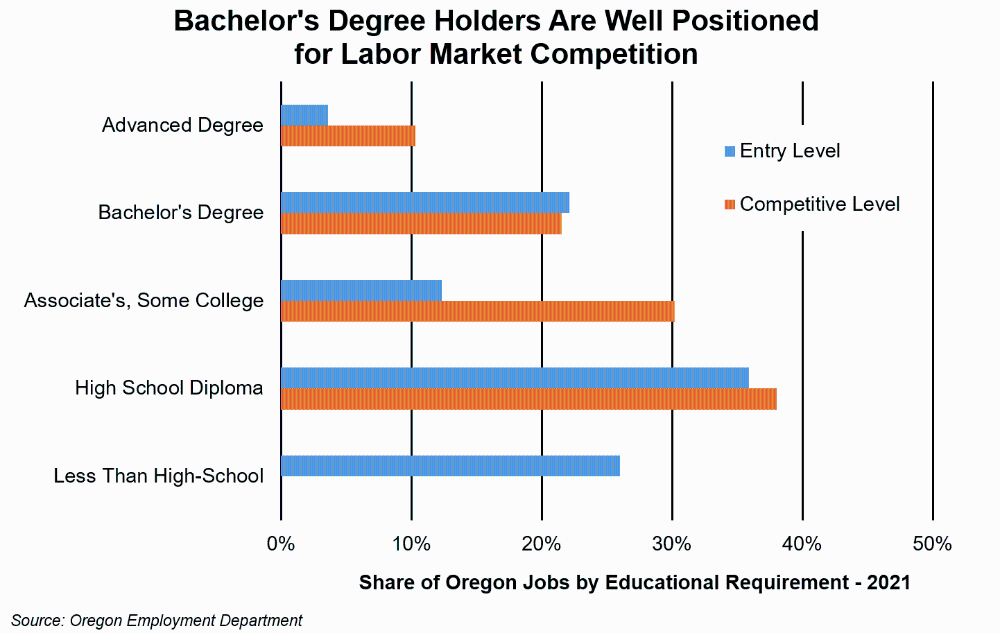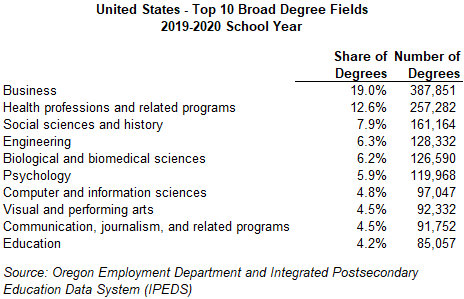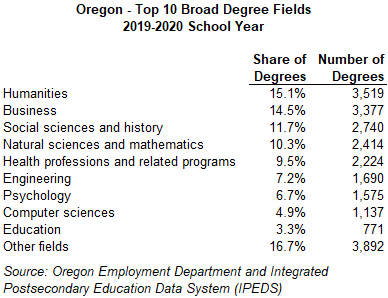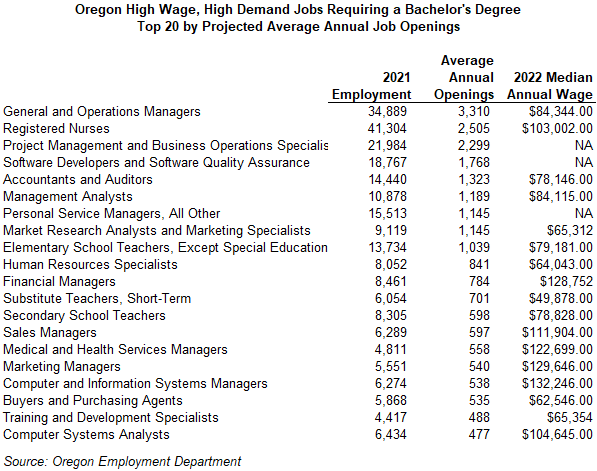Don’t Sell Yourself Short, or the Value of a Bachelor’s Degree
March 23, 2023A 2018 survey by the Pew Research Center found that nearly all adults believe a college degree is valuable. The data reveals that 61% of adults feel a college education is important while an additional 31% feel a college education is essential. Folks are split, however, on the purpose of college. Nearly half of adults feel the main goal is to teach skills and knowledge for workplace preparation. Another 40% feel that personal and intellectual growth should be the focus instead. Some might argue that both goals are essentially the same. From a labor market perspective, the goal is somewhat irrelevant, because the value of a bachelor’s degree is revealed in the data.
The Labor Market is a Market
In general, the labor market functions like any marketplace. There are two positions: the buyer and the seller. The buyer searches for the best available product (to meet their needs) and hopes to purchase at the lowest price. In this way, the buyer maximizes value. The seller seeks to convince the buyer that their product is best (for the buyer’s needs) and hopes to sell at the highest price. In this way, the seller maximizes profit. Since businesses sell products and people buy them, it’s common to think of the employer as the seller and the job seeker as the buyer. However, in the labor market this relationship is flip-flopped. An employer wants to rent a specific skillset and searches for a job seeker who has that skillset. A job seeker wants to rent out their specific skillset and searches for an employer who wants to rent it. In other words, the employer seeks to buy a specific product and the job seeker seeks to sell a specific product. The employer is the buyer and the job seeker is the seller.
In the marketplace, buyers and sellers haggle over price and quality. Supply and demand influence the price paid as well as the quality of products available and the ease of sale. When supply is abundant and demand is limited, a buyer can pay a lower price for a higher quality product. On the other hand, when supply is limited and demand is high, a seller can charge a higher price for a lower quality product. Higher educational achievement is often used as a proxy for the quality of job seekers in a market where employers – buyers – have insufficient information about the quality of the specific product they’re buying. Bachelor’s degree holders spend at least four years obtaining a degree. Although college entrants may be prevented from completing a degree for a variety of reasons, completion reflects motivation and an ability to focus, follow through, and finish. In the labor market, college graduates are seen as high quality products that require less time and cost to train for job specific duties. They represent a low-risk, high-value investment to employers.
When Competition is High, Degree Holders Have an Edge
U.S. Census data shows that nearly 36% of 25 to 64 year olds in Oregon held a bachelor’s degree or higher in 2021; roughly 23% held a bachelor’s degree while 13% held a graduate or professional degree. National figures were similar: 35% overall, with bachelor’s degree holders just 1.0 percentage point lower than Oregon at 22%. Along with this, close to 10% of Oregon’s working-age population held an associate’s degree and 24% had at least some college, but no degree: 9% and 20% for the U.S. metric, respectively. This means that nearly 70% of working-age adults in Oregon sought some level of higher education after high school.
In the United States, roughly 62% of 2021 high school graduates went on to enroll in colleges or universities for the fall 2021 term, according to the Census Bureau’s Current Population Survey. In addition, data from the National Student Clearinghouse shows that 62% of the 2015 college cohort graduated from either a four-year or a two-year institution by 2021. Cohort graduation rates continue to increase and are up roughly 9.0 percentage points since 2009. This and other data highlights the trend of an increasingly educated workforce.

Bureau of Labor Statistics data shows that just over 24% of employment nationally in 2021 was in occupations that required a bachelor’s degree, up 1.7 percentage points from 2019. Meanwhile, nearly 39% of employment was in occupations where the entry-level education requirement was a high school diploma (virtually unchanged) and another 22% of employment was in occupations where the requirement was less than a high school education (down 2.1 percentage points). Oregon’s employment situation is similar. In 2021, roughly 22% of jobs required a bachelor’s degree, 36% required a high school diploma, and 26% required less than a high school diploma. This means that for 62% of jobs, employers sought workers with either a high school education or less.
However, although the majority of jobs required a high school diploma or less, this was generally the minimum requirement. Applicants with any bachelor’s degree are highly competitive for the majority of these positions. Many occupations that require high school or less for entry can offer relatively high wages with wage growth potential and advancement opportunities. Photographers, police and sheriff’s officers, building inspectors, and many supervisor or management jobs are just a few examples. Occupations in the high-wage high school or less category generally rely more heavily on problem solving, organization, computer software, and interpersonal skills, than they do on repetitive physical tasks.
In addition, since the supply of non-skilled workers (those able to fill a non-skilled position) is the entire labor force, job seekers with a bachelor’s degree find it easier to sell their skillset across all non-degree specific occupations in the labor market. In contrast to high school graduates who potentially have the minimum skillset for 62% of Oregon jobs and non-graduates who have the skillset for 26% of jobs, holders of a bachelor’s degree potentially have the skillset for 96% of jobs. This includes jobs requiring an associate’s degree as well as those requiring postsecondary education. Keep in mind that some jobs require specific degrees, training, certificates, or licensing, so the actual share of jobs an individual job seeker qualifies for is likely lower than just stated.
When Demand Drops, Resilience Offers Degree Holders an Edge
The unemployment rate for people 25 years or older, with a bachelor’s degree or higher, averaged 3.0% from 2012 to 2021 in the United States. For people with only a high school diploma the rate averaged 6.0% and for those without a high school diploma the rate averaged 8.5%. Oregon rates for the period were similar, though nearly 1.0 percentage point lower for those without a high school diploma: 3.3% for those with a degree, 6.2% for high school diploma, and 7.6% for no diploma. These averages were driven up by the Great Recession (2007-2009) when the unemployment rate peaked at 12.3% overall for Oregon. In 2009, the rate for bachelor’s degree holders averaged 5.9% while the rate for high school diploma was 13.1% and 18.1% for less than high school.
As a share of the labor force, the available supply (those searching for work) of degree holders is lowest during economic expansions and highest during recessions. The available supply increases during a recession as both degree holders and those without a degree lose jobs. Since the labor pool during this time is saturated with all education levels and overall demand for workers is low, employers can increase minimum job qualifications and pay lower prices for higher skillsets. Degree holders have an easier time retaining or regaining employment during these tough economic times. The downside is that degree holders may find themselves underemployed (in jobs that don’t require their specific degree). The upside is that the unemployment rate for bachelor’s degree holders remains relatively low.
COVID-19 brought another economic shock that altered labor market conditions. The unemployment rate for bachelor’s degree holders in Oregon rose from an average of 2.2% in 2019 prior to the pandemic, to an average of 4.3% in 2020 during the pandemic. Rates for lower education levels rose more significantly. The unemployment rate for associate’s degree or some college rose from 3.5% to 8.1%, the rate for high school diploma rose from 4.0% to 8.7%, and the rate for less than high school jumped from 3.0% to 10.5%.
Bachelor’s degree holders were less likely to have their job status affected by the pandemic due in part to resilience. The largest initial employment impacts of the pandemic were in manufacturing, retail trade, education, health services, and in leisure and hospitality. Leisure and hospitality saw the largest and longest sustained impact. Other industries bounced back more quickly, aided in part by shifting to remote work where feasible. A large portion of bachelor’s degree holders work in jobs where a shift to remote work is feasible and can be done relatively quickly, whereas a large portion of workers with less than a bachelor’s degree are in jobs where a shift is less feasible, because their essential job duties require them to be on-site.
Demographic data for unemployment insurance claims in Oregon became available during the pandemic. This data also highlights the relationship between education level and unemployment. Monthly continued claims for unemployment insurance are highest among those with a high school diploma or less. From January 2019 to February 2023, those with a high school diploma or less accounted for on average 60% of continued claims filings. Those with a bachelor’s degree or higher, and associate’s degree or some college each accounted for 20% on average. On the low side, bachelor’s degree holders accounted for 17.4% of unemployment insurance claims and on the high side accounted for 24.8% of claims during the period.
Degree Holders Choose Which Product They Sell
According to the American Community Survey, in 2021 median annual earnings in the U.S. for workers with less than a high school education were $28,085 and for workers with a high school education they were $35,019. At the same time, median annual earnings for workers with a bachelor’s degree were $61,073. In Oregon in 2021, median annual earnings for workers with less than a high school education were $31,335, and for high school they were $36,031. Workers with a bachelor’s degree had median annual earnings of $57,419.

Not all bachelor’s degrees are equal in the labor market. For example, two degrees that potentially offer low returns on investment are history and performing arts. These degrees are very popular so competition for jobs is fierce because the supply of job seekers is high relative to the available degree specific job openings (predominately in teaching). This means that job seekers who hold these degrees must often look outside of their fields for work. When looking outside of their fields they likely face increased competition because these degrees may lack transferable, in-demand skills.

Two of the biggest factors in the value of a degree are choice of degree and choice of where to live. The second component will likely become less important over time for workers with a degree that enables remote work. The pandemic opened the door to a large-scale shift away from a requirement that employees who can work remotely, still need to show up on-site. This trend is likely to continue. Although, if you choose to pursue a degree that generally requires essential tasks to be performed on-site, such as aerospace engineering, location may continue to be a significant factor. Aerospace engineering has a median annual wage of $85,051 in Oregon; however, if you live in Eastern Oregon you’ll find little work in your field (predominately aerospace manufacturing). In Eastern Oregon you’re better off with a degree in teaching, nursing, or business.
To learn which occupations are in demand in Oregon, go to Qualityinfo.org/pubs and download the Oregon Occupations in Demand spreadsheet from the publications download section near the bottom of the page. You can also use the Occupation and Wage Information - Occupation Profiles tool to learn more about an individual occupation. This tool can be used to view current and projected job openings by location, licensing requirements, educational requirements, schools and training providers, and much more.

Degrees that offer high monetary return on investment are typically those that translate directly to a specific occupation, which has low supply of qualified workers and high demand from employers. Nursing and accounting are two examples of degrees that offer potentially high returns on investment. These degrees are directly transferable to two high-demand occupations in Oregon: registered nurse, which had a median annual salary of $103,002 in 2022; and accountant, which had a median annual salary of $78,146. One common theme among current high-wage, high-demand jobs is a relationship to STEM degrees: degrees involving science, technology, engineering, and math. Another common theme is management.
In 2014, The Hamilton Project used data from the American Community Survey to calculate expected annual and career earnings for 80 college majors. This data was later adjusted for inflation to reflect earnings in 2018 dollars, and also expanded to include 98 college majors. Their interactive graphs allow comparison between majors as well as associate’s degree; some college, no degree; high school diploma; and no diploma. Career earnings were $1.46 million (in 2018 dollars) for bachelor’s degree holders in the 50th percentile, $0.77 million for high school graduates, and $0.59 million for non-graduates.
Another helpful data source is the U.S. Census Bureau’s Post-Secondary Employment Outcomes (PSEO) website. The “PSEO data provide earnings and employment outcomes for college and university graduates by degree level, degree major, and post-secondary institution.” View the U.S. map to choose a state and access the data tool. Because the tool is relatively new, not all states or institutions are available. Oregon data is available though and you can use the tool to compare earnings outcomes by major and institution, and university as well as community college. This link shows an example comparing two degrees from Oregon State University.
The Value is in Your Hands
Understanding the labor market is vital to understanding the value of a bachelor’s degree. When the job seeker views their degree as a product they sell in the marketplace, college becomes a manufacturing process used to make a better product. Compensation, industry, work environment, employment opportunities, and advancement potential are all related to the quality of and demand for the product sold by the job seeker.
Due to labor market demand trends, some college majors offer more value than others. STEM degrees are in high demand and should continue to be in high demand as employers rely more on technology. Oversaturated degree fields find increased competition in degree specific occupations. However, bachelor’s degree holders in general are more competitive across all occupations. Adults may be divided on the purpose of college, but the value of a bachelor’s degree remains high.